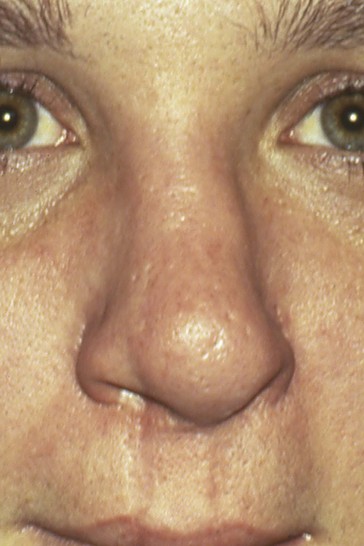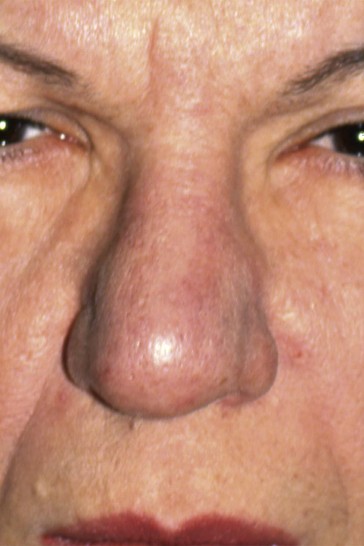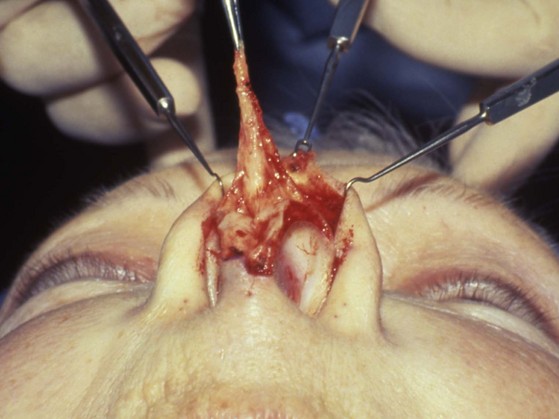Chapter 16 Rhinoplasty in Patients with Thick Skin
Online Contents
In this Chapter Online at experconsult.com
Demonstration of the Surgical Steps on a Patient with Thick Skin Animation 16.1
Demonstration of the Surgical Steps on Another Patient with Thick Skin Animation 16.2
Pearls
• Patients who have excess skin thickness related to sebaceous hypertrophy would benefit from alteration in diet, use of Retin A, and on rare occasions, treatment with Isotretinoin.
• Patients who have excess skin thickness related to thick dermis will incur thinning of the skin over the years if the underlying frame is firm and stable.
• In a small percentage of patients, the amorphous tip configuration is related to the extra fat in between and overlying the domes. To correct this condition, the extra fat is removed, leaving the dermis and a small amount of subdermal fat intact.
• Another crucial step in achieving an optimal rhinoplasty outcome in patients with thick skin is elimination of any dead space.
• A supratip stitch is routinely used on such a patient in order to approximate the supratip skin to the underlying dorsal frame.
One of the anatomical variations that add to the complexity of rhinoplasty is excessive thickness of the nose skin, where achieving optimal tip definition becomes more taxing. Excess skin thickness can result from sebaceous overactivity or inherent thickness of the dermis. The latter represents more of a challenge. There is a difference in the quality of the skin between the patients in Figures 16.1 and 16.2. The patient in Figure 16.1 has large pores and significant sebaceous activity, which can, to a large degree, be controlled by a combination of diet, the use of Retin A and, if necessary, isotretinoin. In contrast, the skin of the patient in Figure 16.2 cannot be altered by these measures. Isotretinoin is not an innocuous drug and should be prescribed under the supervision of a dermatologist. It is detrimental to healing and may cause scar hypertrophy if surgery is performed while the patient is on this medication. It is, therefore, advisable to delay surgery until 6 months after cessation of isotretinoin treatment. Additionally, the use of laser or dermabrasion could be beneficial to patients with sebaceous hyperplasia. Here again, one has to avoid using lasers or dermabrasion for 1 year after treatment with isotretinoin. A better option is to proceed with laser treatment or dermabrasion prior to the use of isotretinoin.
A more difficult example of a patient with thick skin is illustrated in Figure 16.2. This patient has a thick dermis with fewer sebaceous glands. The skin is somewhat red and shiny. The solution in this group of patients is establishment of a firm underlying frame to create reasonable nose definition. The firmer the nose frame, the more likely it is that the skin will become thinner over a period of years and the definition will be close to optimal.
One factor that contributes to the amorphous tip is the presence of extra fat lying between the domes and perhaps overlying them. To correct this unfavorable anatomical presentation, excess fat is removed using an open technique. A columellar incision is made and a healthy nasal tip skin flap is elevated, leaving the excess subcutaneous fibrofatty tissues over the lower lateral cartilages and the part between the domes attached to the underlying frame. After the skin flap is adequately mobilized, the frame is denuded by removing excessive fibrofatty tissue (Figures 16.3, 16.4). It is crucial to ensure that the skin flap is not defatted, since this may not be safe. The flap will still contain the dermis and a small layer of subdermal fat. One must be cautious when performing this operation on current or previous heavy smokers.









